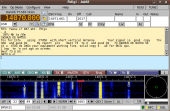Overview
 A great number of exciting new digital operating modes have developed, largely because of the availability of personal computers, soundcards, and advanced software. But amateur digital communication began in earnest in the late 1940's (if you don't count Morse as a digital mode!) when hams worked out techniques of connecting mechanical Teletype keyboard/printers to amateur gear using FSK and AFSK modulation. There are too many different modes to list individually, but here are some of the major ones:
A great number of exciting new digital operating modes have developed, largely because of the availability of personal computers, soundcards, and advanced software. But amateur digital communication began in earnest in the late 1940's (if you don't count Morse as a digital mode!) when hams worked out techniques of connecting mechanical Teletype keyboard/printers to amateur gear using FSK and AFSK modulation. There are too many different modes to list individually, but here are some of the major ones:
- FT8 - In 2025 it is by far the most popular digital mode for award chasing and working DX. It is described in this news story. The WSJT-X software can be downloaded from Joe Taylor's web site. Gary ZL2iFB has written an FT8 Operating Guide.
- Packet - One of the first "modern" digital modes, packet radio transmits data in groups or "packets" of 10s or 100s of bytes. This allows improved throughput and error control. The basic protocol for packet radio is AX.25. Transmission speeds typically range from 300 bps on the HF bands to 1200 and 9600 bps on VHF or UHF.
- PSK31 (or BPSK31, Binary Phase Shift Keying 31.25 Hz) is normally generated and decoded using PC soundcards with one of many available software packages. PSK31 occupies very small bandwidths (approximately 100 Hz) and offers effective communication at low power.
- RTTY (radio teletype) is the original keyboard to keyboard mode, based on the 5-bit Baudot code, began with mechanical Teletypes as mentioned above. It is still a popular communications mode, but now uses PCs for coding and decoding, using 170 Hz frequency shift keying at a 45.45 baud rate -- 60 words per minute.
- Other Modes Many other data modes are available for experimentation, including Pactor and Clover that enhance packet operation, and MFSK, Olivia, Throb, DominoEX, MT63, and Thor which are other modes mainly for PC/soundcard operation. AMTOR is a special form of RTTY that provides error detection and correction.
Books and Publications
General
Legacy Mode Articles
Getting Started in Digital Communications (series)
Introduction, QST March 1992, pp. 33-37
Packet, QST April 1992, pp. 44-49
RTTY, QST May 1992, pp. 41-47
AMTOR, QST June 1992. pp. 34-45
Feedback, QST October 1992, p. 66
The HF Digital "Tower of Babel"
QST January 2001, pp. 50-53
A thumbnail of ten digital modes.
PSK31
- The Warbler--A Simple PSK31 Transceiver for 80 Meters
QST March, 2001. pp. 37-41
- PSK31: A New Radio-Teletype Mode
QEX July/Aug 1999, pp. 3-9
A look at the technical side. - A Panoramic Transceiving System for PSK31
QST June 2000, pp. 31-37
Combine an inexpensive transceiver, some free software and you're on PSK31 at a rock-bottom price! Add to that the fun and pride of building the transceiver and you've got an irresistible package!
MFSK
- MFSK for the New Millennium
QST January 2001, pp. 33-36
Just like RTTY and PSK31...only different. A computer, a sound card and a free download and you're in!
Web Links
General
- Fldigi Multimode Software, Dave Freese, W1HKJ
Supporting many digital modes on Linux, Windows, and MacOS - §97.309(a)(4) Technical Descriptions
FCC descriptions of technical characteristics of digital modes.
Packet
- Site devoted to WinLink© Global Email
- PCsat, A Naval Academy Amateur Radio Satellite
- Green Bay Professional Packet Radio
MFSK
-
Nino Porcino has a STREAM for MFSK16, MFSK8 and other digital modes
Operating Digital Modes
FT8 is by far the most popular digital mode. The FT8 watering holes are constantly filled with activity. Gary ZL2iFB has written an excellent FT8 operating guide.
JS8call has replaced PSK31 as the keyboard to keyboard mode, though 20M PSK31 can still be found. Hamspots.net can be used to set up PSK31 contacts on the other bands. It can be surprisingly difficult to find 40M PSK31 activity.
RTTY is popular mode for contesting. Don AA5AU runs a great RTTY contesting web site.
The WSJT-X suite of software includes modes designed for making reliable QSOs under weak-signal conditions. From the WSJT-X user guide, JT65 was designed for EME (“moonbounce”) on VHF and higher bands, which is still its main purpose today. Q65 is particularly effective for tropospheric scatter, rain scatter, ionospheric scatter, TEP, and EME on VHF and higher bands, as well as other types of fast-fading signals. JT9 was designed for the HF and lower bands. JT4 offers a wide variety of tone spacings and has proven highly effective for EME on microwave bands up to 24 GHz. Other modes support various scatter and propagation applications. Along with WSJT-X, the FLdigi software package supports a lot of other modes, such as CW and RTTY. Hamspots, DXmaps, and PingJockey have chat rooms that can be used to set up contacts, commonly called "Skeds" (short for scheduled) in amateur radio.
Technology >> Radio Technology Topics >> Modes & Systems >> Digital Data Modes




